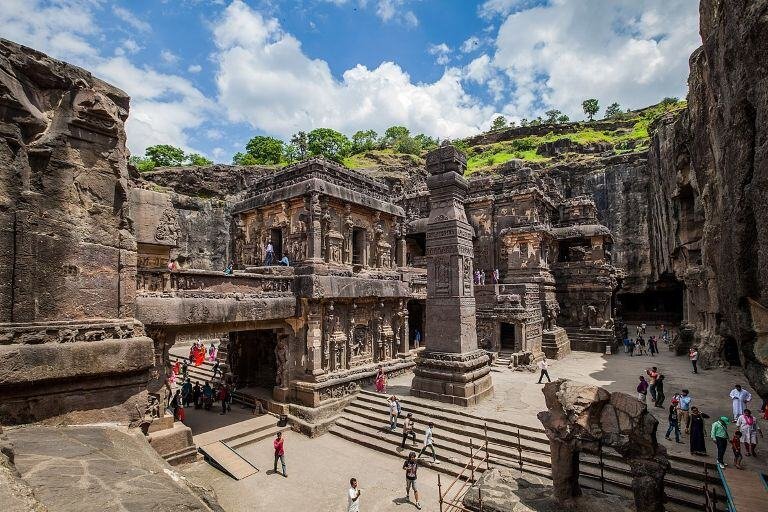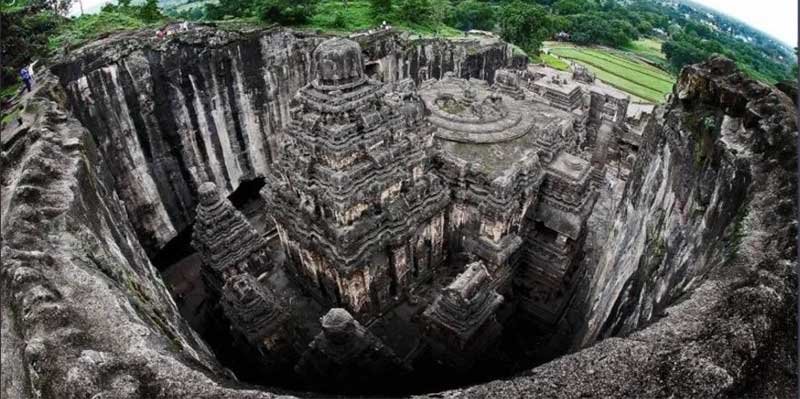kailash temple india – The Kailash Temple india is a temple located in the Ellora Caves in Aurangabad district. It is one of the most spectacular rock-cut temples in India and a UNESCO World Heritage Site.
Features of the kailash temple india:
Monolithic Structure:
The temple is carved out of a single block of basalt rock, making it one of the largest monolithic structures in the world.
Dedicated to Lord Shiva:
The temple is a symbolic representation of Mount Kailash, the abode of Lord Shiva.
Architecture:
Built in the 8th century during the reign of the Rashtrakuta king Krishna I, the temple reflects incredible engineering and artistry. The intricate carvings include idols of deities, mythological scenes, and detailed motifs.
Excavation Technique:
The temple was carved from the top down, which means the artisans started carving from the top of the rock and worked downwards, an extraordinary feat of engineering.
Dimensions:
It is approximately 164 feet long, 109 feet wide, and 98 feet high.
Ornamentation:
The temple features beautifully carved pillars, detailed sculptures, and depictions of stories from Hindu mythology, especially the Ramayana and the Mahabharata.

Cultural Significance:
The Kailasa Temple is not only a place of worship but also an architectural marvel, attracting tourists, historians and architects from all over the world. It is a testimony to ancient Indian craftsmanship and devotion.
kailash temple india:
Located in the beautiful surroundings of the Ellora Caves in Aurangabad district, the Kailash Temple is a timeless testimony to the brilliance of ancient Indian craftsmanship and devotion. Known for its colossal scale, intricate carvings and spiritual significance, the temple attracts pilgrims, historians and art lovers from all corners of the world. Its extraordinary construction, which involved carving out a single piece of rock, makes it one of the greatest architectural marvels in human history.
The Kailash Temple india, also known as the Kailasa Temple, is one of the most prominent structures in the Ellora Caves complex, a UNESCO World Heritage Site. This architectural marvel was built in the 8th century by the Rashtrakuta king Krishna I in honour of Lord Shiva. The design of the temple is inspired by Mount Kailash, the mythical abode of Lord Shiva, and it symbolises divine power and spirituality.

A Masterpiece in Rock-Cut Architecture:
One of the most striking features of the Kailash Temple in Maharashtra is that it was carved out of a single monolithic rock. The construction process was an incredible feat of engineering and artistry. The artisans began carving from the top of the rock, and proceeded by working downwards – a technique known as “vertical execution”. This method ensured precision and consistency, allowing them to achieve intricate details without compromising structural integrity.
To create this masterpiece, around 200,000 tonnes of basalt rock were carefully removed. The sheer scale of the project suggests that thousands of skilled labourers, artisans and sculptors must have worked on it for decades. Despite these challenges, the proportions and symmetry of the temple remain flawless.
Architectural Splendor:
The Kailash Temple india measures approximately 164 feet in length, 109 feet in width and 98 feet in height. Its dimensions make it one of the largest monolithic structures in the world. The temple complex has several architectural components, each of which is carefully sculpted to perfection.
Main Temple:
The main shrine of the temple houses a Shiva Linga, which symbolizes the presence of Lord Shiva. The sanctum sanctorum is surrounded by intricately carved pillars and walls, adorned with sculptures of deities, divine beings and mythological scenes. The precision in these carvings highlights the exceptional skill of the artisans.
Mandap and Nandi Mandap:
In front of the main shrine is a large mandap (pillared hall), which has exquisite carvings of deities and mythology. A separate mandap houses a magnificent sculpture of Nandi, the sacred bull of Lord Shiva, facing the sanctum sanctorum. The alignment of the Nandi Mandap and the sanctum sanctorum reflects a deep understanding of religious symbolism and architectural principles.
The walls, ceilings and pillars of the Kailash Temple are adorned with elaborate carvings that depict episodes from the Ramayana, the Mahabharata and the Puranas. These sculptures are not only aesthetically stunning but also narrate important cultural and religious stories. Scenes such as the battle between Ravana and Lord Shiva and the Samudra manthan (churning of the ocean) are particularly captivating.
Symbolism and Spiritual Significance:
The Kailash Temple india symbolizes Mount Kailash, the heavenly abode of Lord Shiva. The temple’s design, sculptures, and layout reflect the spiritual philosophy of Shaivism. It serves as a sacred space where devotees can connect with the divine and experience transcendence.
Moreover, the temple’s alignment with cosmic principles and its intricate nuances suggest a deep understanding of Hindu cosmology. Every element from the sculptures to the spatial layout is imbued with symbolic meaning, making the temple not just a place of worship but also a repository of ancient wisdom.
Artistic Brilliance:
The artistic brilliance of the Kailash Temple lies in its detailed carvings and innovative design. The artisans have skillfully integrated various architectural styles and cultural influences into the temple’s design. For instance, the temple’s tiered structure resembles a Dravidian-style gopuram, while the intricate carvings reflect the influence of Gupta and Chalukya art. Each sculpture in the temple tells a story. The depiction of gods, animals and divine beings reflects the artisans’ mastery of anatomy, proportion and expression. The level of detail achieved in these sculptures is remarkable, with even the smallest features rendered with precision.
Preservation and Challenges:
Despite its grandeur, the Kailash Temple india faces a number of conservation challenges. Natural erosion, weathering, and human activities are significant threats to this ancient monument. Conservation efforts being undertaken by the Archaeological Survey of India (ASI) and other organisations aim to protect and restore the temple’s intricate carvings and structural integrity.
In recent years, advances in technology such as 3D mapping and laser scanning have been used to document and preserve the temple. These efforts are crucial in ensuring that future generations can marvel at the brilliance of the artisans who built the Kailash Temple.
Tourist Attraction:
The Kailash Temple india is one of the most visited tourist destinations in India. It attracts millions of visitors every year, including pilgrims, historians, and architecture enthusiasts. Guided tours of the Ellora Caves provide visitors with information about the temple’s history, artistry, and cultural significance.
Apart from the Kailash Temple, the Ellora Caves complex contains 33 other caves, including Buddhist monasteries and Jain temples, making it a unique amalgamation of religious and cultural traditions. Visitors to the site are often impressed by the harmonious coexistence of these diverse traditions, reflecting India’s rich heritage of tolerance and inclusiveness.
Legacy and Global Recognition:
The Kailash Temple india is not only an architectural marvel but also a symbol of India’s rich cultural and spiritual heritage. Its inclusion in the UNESCO World Heritage List highlights its global significance and underlines the need for its preservation.
Scholars and architects around the world consider this temple a masterpiece of ancient engineering and artistry. Its influence can be seen in subsequent architectural works in India and abroad. The Kailash Temple inspires awe and reverence, reminding us of the ingenuity and devotion of ancient Indian craftsmen.
Conclusion:
The Kailash Temple india is a timeless monument of human creativity, devotion and perseverance. Its extraordinary structure, intricate carvings and spiritual symbolism make it one of the most remarkable achievements of ancient Indian civilization. When we look at this architectural marvel, we are reminded of the ingenuity and dedication that went into its construction. The Kailash Temple Maharashtra is not just a temple – it is a celebration of art, spirituality and the enduring legacy of India’s cultural heritage.
You can also read…










